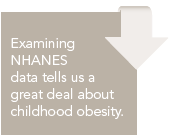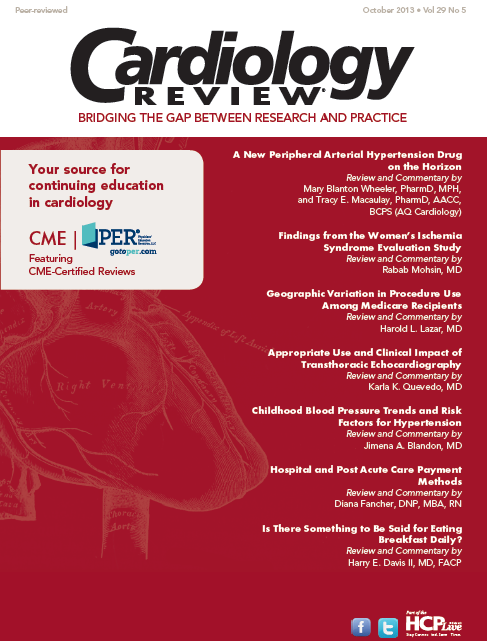Publication
Article
Cardiology Review® Online
Childhood Blood Pressure Trends and Risk Factors for Hypertension
Author(s):
Examining data from the National Health and Nutrition Exam Survey tells physicians a great deal about childhood obesity and risk factors for high blood pressure.

Jimena A. Blandon, MD
Review

Rosner B, Cook NR, Daniels S, Flakner B. Childhood blood pressure trends and risk factors for high blood pressure: the NHANES experience 1988-2008. Hypertension. 2013;62:247-254.
Modern society is full of technological wonders and an abundance of tasty food. These might be just 2 factors among many others that encourage children to choose a less active lifestyle instead of going out to play, run, and engage in sports. There has been an increasing awareness of the changing body weight in American society in general and young kids in particular, with more than one-third of children and adolescents being overweight or obese in 20101 and presenting with long-term complications of diabetes mellitus (DM) and hypertension (HTN).2 To what extent is this epidemic of obesity in childhood and its deleterious effects a real problem or just an invention of the media?
The National Health and Nutrition Exam Survey (NHANES) is a well-known longitudinal study that has been following a large cohort of children since 1988 and has addressed the question of trends in obesity, nutrition, and increased blood pressure (BP).
Study Details
In this recent analysis by Rosner et al,3 NHANES data was examined to find a trend in blood pressure increase and possible risk factors associated with it. The authors considered 2 cohorts: 3,248 children from NHANES III, conducted from 1988 to 1994, and continuous NHANES with 8,388 children followed up from 1999 to 2008, aged 8 to 17 years at the time of the study enrollment, with 1 or more BP measurements and ethnicity self-reported as non-Hispanic white, black, or Mexican-American.
A few exclusion criteria were considered: (a) all other ethnicities due to small number represented; (b) body mass index (BMI) z scores less than -6 or greater than 6; (c) actual caloric intake <0.5 recommended caloric intake or greater than twice the recommended caloric intake for their age and sex norms; and (d) missing data, including BP or waist circumference measurements, BMI, and caloric intake. This exclusion list reduced the initial total of 16,693 children screened to the final total of 11,672.
The main outcome measure was elevated BP, defined as systolic BP (SBP) or diastolic BP (DBP) ≥90th percentile or systolic BP/diastolic BP ≥120/80 mm Hg. Other important variables were: BMI; waist circumference; and nutrient, sodium (Na), and caloric intake.
BP was measured with a sphygmomanometer by certified examiners after children rested quietly while sitting for 5 minutes. A median of 3 BP readings (or of all BP readings, if fewer than 3) was used. The prevalence of elevated BP was compared between the NHANES 1999 to 2008 and NHANES III population. BMI values were converted to age-sex—specific percentiles based on Centers for Disease Control (CDC) growth charts, and converted to BMI z scores using the probit transformation. Waist circumference z scores were computed by ranking subjects by 1-year age-sex groups, also using the probit transformation. Nutrient intake took into account 9 components (total fat, saturated fat, carbohydrates, protein, calcium, fiber, magnesium, and potassium) and was measured by a single day of 24-hour recall and compared with the recommended daily intake (RDI) based on nutritional guidelines for children. Intake of sodium was adjusted for total caloric intake [(Na intake) × 2000/total caloric intake] and expressed in quintiles. Researchers obtained recommended caloric intake for children corrected for age and sex.
There was a significant decrease in the percentage of non-Hispanic whites (P <0.05) and a significant increase in the percentage of Mexican Americans (P <0.01) for both sexes.
Mean SBP significantly increased for both boys (106.1 vs 107.8 mm Hg; P = 0.001) and girls (102.3 vs 104.9 mm Hg; P <0.001). However, mean DBP significantly increased among girls (57.0 vs 59.0 mm Hg; P = 0.003), but not among boys (57.7 vs 56.7 mm Hg; P = 0.13). The prevalence of elevated BP significantly increased among girls (8.2% vs 12.6%; P = 0.007), but was only of borderline significance among boys (15.8% vs 19.2%; P = 0.057). However, in general, this investigation found a higher prevalence of elevated BP in NHANES 1999 to 2008 versus NHANES III (an estimated 27%), but was not statistically significant (odds ratio [OR] = 1.27; P = 0.069).
BMI increased significantly for both boys (P ≤0.016) and girls (P <0.001). The percentage of overweight children (≥85th percentile) also significantly increased (27.2 to 35.1 for boys, and 25.4 to 33.3 for girls, both P <0.001), and there were also significant increases in waist circumference for boys (72.3 to 75.4, P <0.001) and especially for girls (70.6 to 75.2, P <0.001).
A majority of children were above the RDI for total fat, saturated fat, protein, and Na. Also, a majority were below the RDI for calcium, carbohydrates, fiber, magnesium, and potassium.
The authors used several mathematic models to assess the impact of the different risk factors (alone or combined) on elevated BP. They found significant positive associations between prevalence of elevated BP and elevated Na intake (>3,450 vs ≤2,300 mg; OR = 1.37 or 36%; P = 0.017; P trend = 0.038) and reduced carbohydrate intake (≤200 vs >300 g; OR = 1.33; P = 0.20; P trend = 0.021). However, after adjustment for BMI and waist circumference z score, only the association with Na intake remained significant (>3,450 vs ≤2,300 mg, OR = 1.36, P = 0.024; 2,301 mg-3,450 mg, OR = 1.17, P = 0.21), P trend over all 3 Na groups = 0.045. Both BMI and waist circumference made independent contributions to the prevalence of elevated BP, after being adjusted by quintiles. The odds for elevated BP also increased 12% for every 1-year increase in age (P <0.001), and was higher for boys than girls (OR = 1.85; P <0.001), and was higher for black than non- Hispanic white children (OR = 1.28; P = 0.002).
CommentaryOur Fears Are Real
This study demonstrates that our fears are real: BP is progressively increasing at very young ages, which can pose a threat of potential target-organ damage in the long term.4 Several factors are contributing to this change. The most potent factor related to the increased BP seen in this study was Na intake, possibly related to dietary patterns in the young US population.5
The strengths of this study are: (1) large sample size, actually larger than any other previous studies; (2) adjustment for multiple variables to clarify interrelations among them, with very well conducted statistical models and; (3) solid design and conclusions. The study’s limitations involved the nature of the design because the NHANES study did not provide follow-up in BP measurements, limiting future trends. Also the daily intake only took into consideration a 24-hour period, which might not be representative of a regular daily diet.
The theoretical mechanism of salt intake and sensitivity related to HTN has been well documented in adults and now in children,6 which should prompt a massive call to action at all levels in improving child nutrition to avoid an epidemic of catastrophic dimensions in the future. If this trend, observed in even a 12-year time span, continues, the future can be one in which our children have end-stage renal disease, diabetes mellitus, and stroke all due to obesity, HTN, and bad dietary habits. Parents will have to play a more active role in their kids’ health, but we as a society also need to have fewer fast food chains and more healthy options, as well as more security in our communities, so our children can go outside and play freely, like it used to be in the old days.
This study exposed a worrisome problem, and is of paramount importance. The information it provides will need to be examined deeply, and similar studies must be undertaken for years to come to see if this trend reverses or worsens. Before that, with this data, we must all get involved in our children’s diet, physical activity, habits, and health care before is too late!
References
1. Ogden CL, Carroll MD, Kit BK, Flegal KM. Prevalence of obesity and trends in body mass index among US children and adolescents, 1999- 2010. JAMA. 2012;307:483-490.
2. Li C, Ford ES, Zhao G, Mokdad AH. Prevalence of pre-diabetes and its association with clustering of cardiometabolic risk factors and hyperinsulinemia among US adolescents: NHANES 2005—2006. Diabetes Care. 2009;32:342-347.
3. Rosner B, Cook NR, Daniels S, Falkner B. Childhood blood pressure trends and risk factors for high blood pressure: the NHANES experience 1988-2008. Hypertension. 2013;62:247-254.
4. McMahan CA, Gidding SS, Malcom GT, Tracy RE, Strong JP, McGill HC Jr. Pathobiological determinants of atherosclerosis in youth research group. Pediatrics. 2006;118:1447-1455.
5. Briefel RR, Johnson CL. Secular trends in dietary intake in the United States. Annu Rev Nutr. 2004;24:401-431.
6. He FJ, MacGregor GA. Importance of salt in determining blood pressure in children: a meta-analysis of controlled trials. Hypertension. 2006;48:861-869.
About the Author
Jimena A. Blandon, MD, is an internal medicine specialist currently doing her subspecialization in nephrology at Cleveland Clinic Florida, in Weston, FL. She received her MD at Universidad del Valle in Cali, Colombia.






